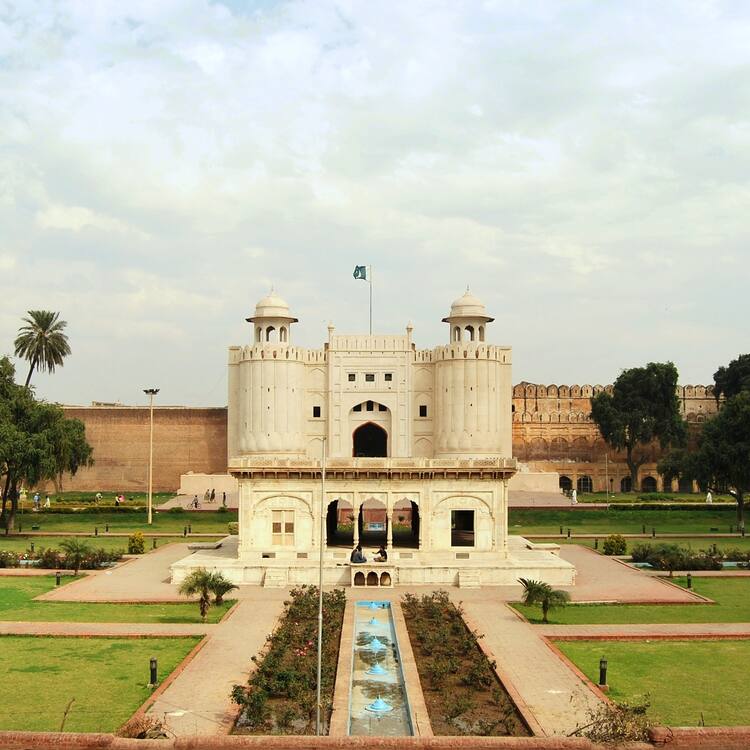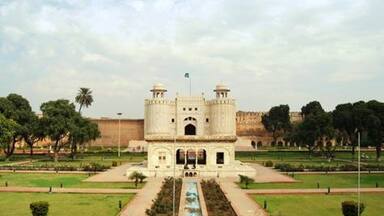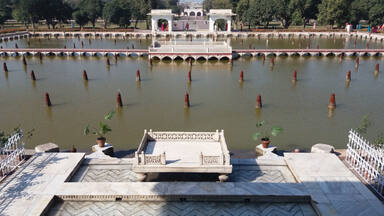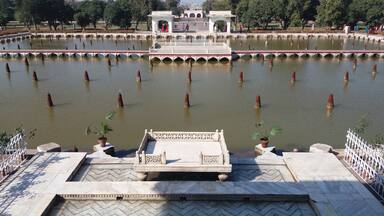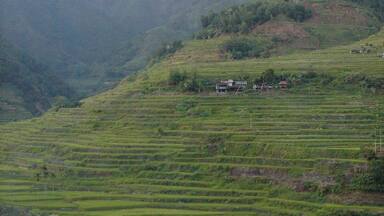Fort and Shalamar Gardens in Lahore
Fort and Shalamar Gardens in Lahore
These are two masterpieces from the time of the brilliant Mughal civilization, which reached its height during the reign of the Emperor Shah Jahan. The fort contains marble palaces and mosques decorated with mosaics and gilt. The elegance of these splendid gardens, built near the city of Lahore on three terraces with lodges, waterfalls and large ornamental ponds, is unequalled.
Description is available under license CC-BY-SA IGO 3.0
Fort et jardins de Shalimar à Lahore
Il s'agit de deux chefs-d'œuvre de la brillante civilisation moghole à son apogée, au temps de l'empereur Shah Jahan. Le fort de Lahore renferme des palais et mosquées de marbre, ornés de mosaïques et de dorures. À proximité de la ville, les merveilleux jardins de Shalimar étagés sur trois terrasses, avec des pavillons, des cascades et de vastes pièces d'eau, sont d'un raffinement sans égal.
Description is available under license CC-BY-SA IGO 3.0
حصن وحدائق شاليمار في لاهور
انها التحف التي تعود الى حضارة المغول اللامعة وهي في ذروة ازدهارها في عهد الامبراطور شاه جهان. ويضم حصن لاهور قصورًا ومساجدَ من المرمر مزخرفة بالفسيفساء وبطبقات الذهب. وبالقرب من المدينة تقع حدائق شاليمار المدهشة المقسّمة على 3 مصطبات والتي تتضمَّن جناحات وشلالات وبقع مياه واسعة، تظهر دقة لا مثيل لها.
source: UNESCO/CPE
Description is available under license CC-BY-SA IGO 3.0
拉合尔古堡和夏利玛尔公园
辉煌的莫卧尔文化中有两个典范在沙贾汉国王统治时期达到顶峰——包括建有宫殿的要塞和用马赛克和镀金饰品装饰起来的清真寺。在拉合尔城附近的园林都建在三层平台上,带小屋、瀑布和巨大的装饰水池;这些园林的优雅和美丽简直无与伦比。
source: UNESCO/CPE
Description is available under license CC-BY-SA IGO 3.0
Форт и сады Шалимар в городе Лахор
Эти два шедевра относятся к тому времени, когда блестящая цивилизация Великих Моголов достигла своего расцвета при императоре Шах-Джахане. В форте находятся мраморные дворцы и мечети, украшенные мозаиками и позолотой. Вблизи города Лахор были разбиты роскошные сады Шалимар, где на трех террасах были сооружены павильоны, водяные каскады и большие декоративные бассейны.
source: UNESCO/CPE
Description is available under license CC-BY-SA IGO 3.0
Fuerte y jardines de Shalamar en Lahore
Este sitio comprende dos obras maestras del periodo de apogeo de la civilización mogol, en tiempos del emperador Sha Jahan. El fuerte de Lahore encierra en sus murallas un conjunto de palacios y mezquitas de mármol ornamentados con mosaicos y dorados. En las cercanías de la ciudad, los espléndidos jardines de Shalamar, escalonados en tres terrazas, ofrecen un ejemplo inigualable de refinamiento artístico con sus pabellones, cascadas y vastos estanques.
source: UNESCO/CPE
Description is available under license CC-BY-SA IGO 3.0
ラホールの城塞とシャーリマール庭園
ラホールはカラチに次ぐパキスタン第二の都市。東西約2km、南北約1.5kmの城塞都市。ムガール帝国第3代アクバル帝の時代に再建が始まり、以後6代目まで4人の王が増改築を重ね、同帝国最盛期の威勢を示す大建築群を建設した。ラホール城塞の北東約3kmには、17世紀にシャー・ジャハーンが保養地としてつくったペルシア式のシャーリーマール庭園がある。source: NFUAJ
Fort en Shalamar tuinen in Lahore
Dit zijn twee meesterwerken uit de tijd van de schitterende Mogol beschaving, die zijn hoogtepunt bereikte tijdens de regering van keizer Shah Jahan. Het fort bevat marmeren paleizen en moskeeën gedecoreerd met mozaïeken en vergulde elementen. De 21 monumenten die bewaard zijn gebleven binnen het fort vormen een prachtige collectie van de Mogol architectuur, gekenmerkt door een gestandaardiseerde bouw met baksteen en metsellagen van rode zandsteen verluchtigd met Hindoe motieven. De elegantie van de 16 hectare grote Shalamar Tuinen is ongeëvenaard. Ze zijn aangelegd in de buurt van de stad Lahore op drie terrassen met paviljoens, watervallen en grote siervijvers.
Source: unesco.nl
Outstanding Universal Value
Brief synthesis
The inscribed property includes two distinct royal complexes, the Lahore Fort and the Shalimar Gardens, both located in the City of Lahore, at a distance of 7 km. from each other. The two complexes – one characterized by monumental structures and the other by extensive water gardens - are outstanding examples of Mughal artistic expression at its height, as it evolved during the 16th and 17th centuries. The Mughal civilisation, a fusion of Islamic, Persian, Hindu and Mongol sources (from whence the name Mughal derives) dominated the Indian subcontinent for several centuries and strongly influenced its subsequent development.
The Lahore Fort, situated in the north-west corner of the Walled City of Lahore, occupies a site which has been occupied for several millenia. Assuming its present configuration during the 11th century, the Fort was destroyed and rebuilt several times by the early Mughals during the 13th to the 15th centuries. The 21 monuments which survive within its boundaries comprise an outstanding repertory of the forms of Mughal architecture from the reign of Akbar (1542-1605), characterized by standardized masonry of baked brick and red sandstone courses relieved by Hindu motifs including zooomorphic corbels, through that of Shah Jahan (1627-58), characterized by the use of luxurious marbles, inlays of precious materials and mosaics, set within exuberant decorative motifs of Persian origins.
Akbar’s efforts are exemplified in the Masjidi Gate flanked by two bastions and the Khana-e-Khas-o-Am (Public and Private Audience Hall). Akbar’s successor, Jahangir, finished the large north court (1617-18) begun by Akbar and, in 1624-25, decorated the north and north-west walls of the Fort. Shah Jahan added a fairy tale-like complex of buildings surrounding the Court of Shah Jahan (Diwan-e-Kas, Lal Burj, Khwabgah-e-Jahangiri, and the Shish Mahal, 1631-32, one of the most beautiful palaces in the world, sparkling with mosaics of glass, gilt, semi-precious stones and marble screening).
The Shalimar Gardens, constructed by Shah Jahan in 1641-2 is a Mughal garden, layering Persian influences over medieval Islamic garden traditions, and bearing witness to the apogee of Mughal artistic expression. The Mughal garden is characterized by enclosing walls, a rectilinear layout of paths and features, and large expanses of flowing water. The Shalimar Gardens cover 16 hectares, and is arranged in three terraces descending from the south to the north. The regular plan, enclosed by a crenellated wall of red sandstone, disposes square beds on the upper and lower terraces and elongated blocks on the narrower, intermediate terrace; within, elegant pavilions balance harmoniously arranged poplar and cypress trees, reflected in the vast basins of water.
Criterion (i): The 21 monuments preserved within the boundaries of Lahore Fort comprise an outstanding repertory of the forms of Mughal architecture at its artistic and aesthetic height, from the reign of Akbar (1542-1605) through the reign of Shah Jahan (1627-58). Equally the Shalimar Gardens, laid out by Shah Jahan in 1641-2 embodies Mughal garden design at the apogee of its development. Both complexes together may be understood to constitute a masterpiece of human creative genius.
Criterion (ii): The Mughal forms, motifs and designs developed at Lahore Fort and Shalimar Gardens have been influenced by design innovations in other royal Mughal enclaves but have also exerted great influence in subsequent centuries on the development of artistic and aesthetic expression throughout the Indian subcontinent.
Criterion (iii): The design of the monuments of Lahore Fort and the features of the Shalimar Gardens bears a unique and exceptional testimony to the Mughal civilisation at the height of its artistic and aesthetic accomplishments, in the 16th and 17th centuries.
Integrity
The inclusion by the World Heritage Committee of the originally separate Lahore Fort and the Shalimar Gardens nominations in a single inscribed property in 1981 broadened the range of design expressions - from monumental structures to water gardens - representing Mughal artistic and aesthetic achievements included in the property, and enhanced the overall integrity of the property. Both of the complexes in the inscription as they survive today are complete in and of themselves; the Lahore Fort complex includes all 21 surviving monuments within the defined Fort boundaries, and the Shalimar Gardens includes all of the various water terraces and pavilions within its enclosing wall.
However missions to the property (2003, 2005, 2009) have noted that the Badshahi Masjid (Royal Mosque) and the Tomb of Ranjit Singh, although located outside the Fort proper form an integral part of its physical and historical context, and suggested their inclusion within the inscribed property would enhance its integrity.
However the accidental destruction of 2 of the 3 hydraulic works and related walls of the Shalimar Gardens in 1999 for widening the Grand Trunk Road from Lahore to Mugha significantly marred the integrity of the Gardens, and the property was placed on the World Heritage List in Danger in 2000. Detailed analysis at the time also revealed considerable deterioration of some constituent monuments and serious urban encroachments affecting some structures. While remedial conservation efforts since 2000 have progressively addressed repair needs of individual monuments, these have not focused on reinstatement of hydraulic systems or components.
Measures to improve property integrity have been identified which include consolidation and protection of damaged water tanks, protection of external walls for both complexes, major investment in upgrading of monuments and features within both complexes, extension of inscribed zones and buffer zones to better protect the Outstanding Universal Value of the two complexes and their settings, consideration of inclusion of adjacent monuments within the inscription, and removal of the urban encroachments and improved control of urban pressures (including tourist bus parking).
Authenticity
The property in general maintains the authentic layout, forms, design and substance of both complexes and the constituent layouts, elements and features associated with the Mughal artistic and aesthetic expressions of the 16th and 17th century. Maintaining authenticity of workmanship necessitates that contemporary repair and conservation work use and revive traditional techniques and materials.
However authenticity of function and of setting has been eroded over time: the original function of these royal complexes has been replaced by public visitation and tourism, and the larger setting of both complexes now accommodates the traffic circulation and functional needs of the contemporary city of Lahore.
Protection and management requirements
The World Heritage property is protected under the Antiquities Act (1975), administered until 2005 by the Department of Archaeology, Pakistan. At that time, management responsibility for the property was delegated from the national level to the provincial level; and the Directorate General of Archaeology, Punjab (DGoA,P) took on overall responsibility for property management. The DGoA,P is working within the guidelines laid down in the two Master Plans established for Lahore Fort and the Shalimar Gardens, and with project financing made available by the Government of Punjab in a “Five Year Programme for Preservation and Restoration of Lahore Fort” and a “Five Year Programme for the Preservation and Restoration of Shalimar Gardens” launched in 2006-2007. The DGoA, P is also being supported in its management efforts by a Steering Committee to guide implementation of planned projects, a Technical Committee to supervise conservation activities and to develop a “conservation plan” on the basis of priorities established in the Master Plans, and a Punjab Heritage Foundation to attempt to provide a permanent source of funding.
The placing of this property on the World Heritage List in Danger has highlighted many threats to the Outstanding Universal Value of the property, and its integrity and authenticity. These include ongoing degradation of the tangible features of the property, insufficient ability to monitor and control urban encroachments on and adjacent to the property, and insufficient ability to control the actions of other agencies which could impact on the Outstanding Universal Value of the property.
The key components of the management response to sustain and protect its Outstanding Universal Value, integrity and authenticity, and to address the above threats include efforts to extend the boundaries of the inscribed area and its buffer zone, to complete and implement the Master Plans for Lahore Fort and Shalimar Gardens, to strengthen local community and institutional awareness of the values of the property and the primary sources of its vulnerability, and to improve co-ordination mechanisms among all stakeholders whose actions could affect the Outstanding Universal Value of the property, in particular national and local authorities involved in carrying out public works and promoting and managing tourism on the property.
